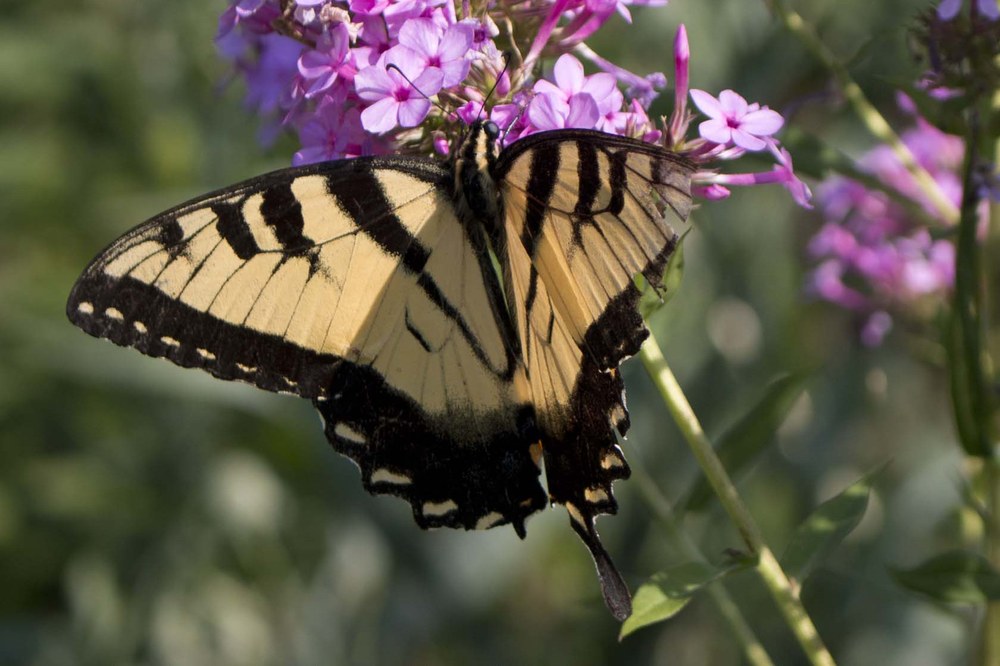The butterfly species on this list are all native to Pennsylvania.

Some of them are found throughout the state and others occur locally in connection with the larval host plants. Many butterfly species have adapted to feed upon non-native plants if the plants are in the same family as the native larval host. Some of these plants are highly invasive and should never be cultivated.
There are additional larval host plants for many of the butterflies listed, especially the species which feed on many plant families. Some butterflies also exhibit local host plant preferences depending upon plant availability and habitat.
Female butterflies can travel for miles in search of host plants to lay their eggs upon. Plant the native species and plant several if the plants are small. Watch for evidence of caterpillars feeding on the leaves, your plants are now part of the food web. Also remember...do not apply pesticides.
| Butterfly | Caterpillar Host Plants |
|---|---|
| Pipevine swallowtail | pipevines (Aristolochia spp.) |
| Zebra swallowtail | pawpaw (Asimina triloba) |
| Black swallowtail | parsley family - parsley, dill, fennel, carrot, Queen Anne's lace, Golden Alexanders (Zizia aurea), rue family - common rue |
| Giant swallowtail | northern prickly-ash (Zanthoxylum americanum), common rue |
| Eastern tiger swallowtail | tuliptree (Liriodendron tulipifera), wild black cherry (Prunus serotina), ash (Fraxinus spp.) |
| Spicebush swallowtail | spicebush (Lindera benzoin), sassafras (Sassafras albidum) |
| Cabbage white (non-native) | mustard family - cabbage, broccoli, cauliflower, Brussels sprouts, garlic mustard, (invasive non-native), winter-cress |
| Clouded sulphur | clovers |
| Orange sulphur | alfalfa, clovers |
| American copper | sheep sorrel, docks |
| Banded hairstreak | oaks (Quercus spp.), hickories (Carya spp.), black walnut (Juglans nigra) |
| Gray hairstreak | flowers and seeds of - tick-trefoils, bush-clovers, clovers, mallows, hibiscus |
| Henry's elfin | redbud (Cercis canadensis), American holly (Ilex opaca), blueberries (Vaccinium spp.) |
| Eastern tailed blue | flowers and seeds of - clovers, bush-clovers, tick-trefoils, sweet clovers |
| Baltimore | white turtlehead (Chelone glabra) |
| Spring azure/summer azure | buds and flowers of - flowering dogwood (Cornus florida), wild black cherry (Prunus serotina), viburnums, blueberries, meadow-sweet (Spiraea spp.), New Jersey tea (Ceanothus americanus), wing stem (Verbesina alternifolia) |
| Variegated fritillary | violets and pansies |
| Great spangled fritillary | violets |
| Meadow fritillary | violets |
| Silvery checkerspot | ox-eye sunflower (Heliopsis helianthoides), sunflowers (Helianthus spp.), black-eyed Susans (Rudbeckia spp.), wing stem (Verbesina alternifolia), coneflowers (Echinacea spp.) |
| Pearl crescent | asters (Symphyotrichum spp.) - excluding white wood aster (Eurybia divaricata) |
| Question mark | hackberry trees (Celtis spp.), elms (Ulmus spp.), nettles |
| Eastern comma | nettles, hops, elms (Ulmus spp.) |
| Mourning cloak | willows (Salix spp.), elms (Ulmus spp.), aspens (Populus spp.), birches (Betula spp.), hackberry tree (Celtis spp.) |
| American lady | pussytoes (Antennaria spp.), pearly everlasting, fragrant cudweed |
| Painted lady | thistles (some are invasive non-natives), mallows, hollyhocks, asters, legumes and many others |
| Red admiral | nettles, false nettle |
| Common buckeye | English plantain, common plantain, figworts, vervains, snapdragon, toadflax |
| Red-spotted purple | cherries (Prunus spp.), willows (Salix spp.), aspens (Populus spp.), serviceberries (Amelanchier spp.), birches (Betula spp.), hawthorns (Crataegus spp.), sweet crabapple (Malus coronaria) |
| Viceroy | willows (Salix spp.), aspens (Populus spp.) |
| Hackberry & Tawny emperors | hackberry trees (Celtis spp.) |
| Appalachian brown | sedges (Carex spp.), bulrush |
| Little wood satyr | bluegrasses, orchard grass |
| Common wood nymph | purpletop grass (Tridens flavus), poverty grass, big bluestem, little bluestem |
| Monarch | milkweeds (Asclepias spp.) |
| Silver-spotted skipper | black locust (Robinia pseudoacacia), honeylocust (Gleditsia triacanthos), tick-trefoils, hog-peanut and other legumes |
| Wild indigo duskywing (skipper) | wild indigo (Baptisia tinctoria), blue false indigo (Baptisia australis), crown-vetch (invasive non-native) |
| Common checkered skipper | mallows, sidas, velvet-leaf, hollyhock |
| Peck's skipper | rice cutters (Leersia oryzoides), bluegrasses |
| Little glassywing (skipper) | purpletop grass (Tridens flavus) |
| Zabulon skipper | purpletop grass (Tridens flavus), lovegrass |
Prepared by York County Master Gardener Debra Carman, February 2017
More information
- Caterpillars of Eastern North America by David L. Wagner, Publisher: Princeton University Press; 1St Edition edition (August 14, 2005)
- Butterflies through Binoculars: The East A Field Guide to the Butterflies of Eastern North America by Jeffrey Glassberg, Publisher: Oxford University Press; 1 edition (January 1999)
- Bringing Nature Home: How You Can Sustain Wildlife with Native Plants by Douglas W. Tallamy, Publisher: Timber Press; Exp Upd edition (April 1, 2009)

